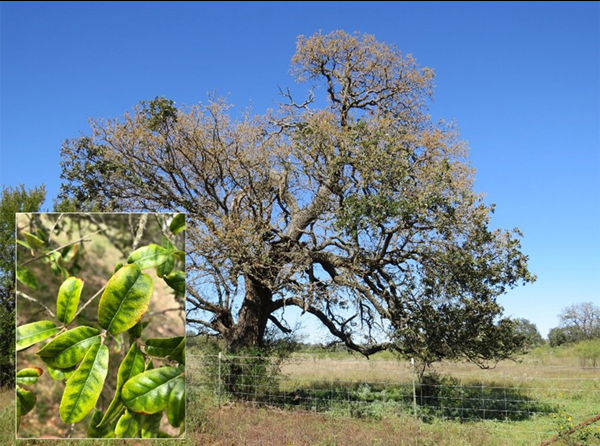Non-game and Threatened and Endangered Research/Monitoring
Oak Wilt

Oak wilt is a disease caused by the fungus Bretziella fagacearum
Oak wilt is a disease caused by the fungus Bretziella fagacearum which effects several oak species. It can be found anywhere with a high density of oak trees which makes central Texas highly susceptible. Once an individual tree is infected, the fungus can then spread to surrounding trees through either the grafted root systems or via sap-feeding insects that may transport fungal spores from an infected tree to a fresh wound on a healthy tree. A widely accepted and commonly used practice to prevent root transmission is to dig a four-foot trench approximately 100 feet from the outermost infected trees. However, it can be difficult and costly to trench in many rocky soils commonly found in the hill country, the roots may occur at deeper depths and the roots will continue to grow back through the trench overtime. It is not uncommon for landowners to find that they need to expand their trenches due to a breach.
Oak wilt was first discovered on the Kerr WMA in 2009. It has been monitored, but no major action was taken for the next 10 years. The infection site increased from about 2 acres in 2009 to roughly 16 acres by 2019. We are currently investigating another method of oak wilt containment that does not require soil disturbance. If successful, then this may offer another option for landowners in rural settings in preventing the spread of oak wilt from existing infection sites.
Threatened and Endangered Species
TPWD, along with academia and the U.S. Fish and Wildlife Service, have been monitoring and studying several threatened and endangered species found on the Kerr WMA. Since the 1990s, Kerr WMA has conducted male territory surveys for the black-capped vireo and golden-cheeked warbler, both neo-tropical songbirds that summer and nest in central Texas. The WMA has also monitored the tobusch fishhook cactus populations under present grazing and fire applications. Given the stability and successful growth of these populations over time, the Kerr WMA additionally serves as a study site and collaborates with other agencies and Universities in the research of these species and many other non-game species occurring in habitats on the Kerr WMA.
Kerr WMA Management Program Endangered Species
Associated works:
- CONKLING, T. J., POPE, T. L., SMITH, K. N., MATHEWSON, H. A., MORRISON, M. L., WILKINS, R. N., & CAIN, J. W. (2012). Black-Capped Vireo Nest Predator Assemblage and Predictors for Nest Predation. The Journal of Wildlife Management, 76(7), 1401–1411. www.jstor.org/stable/23251438
- Dufault, D. 2004. Habitat occupancy by the black-capped vireo (Vireo atricapillus) following prescribed burns at Kerr Wildlife Management Area (masters thesis). Texas State University.
- Holden, R. S., Morrison, M. L., & Mathewson, H. A. (2018). The Influence of Temperature on Black-Capped Vireo Nest-site Selection. Southeastern Naturalist, 17(1), 95–103.
- Langley, L.A. 2015. The pollination ecology of Sclerocactus brevihamatus ssp. tobuschii (Cactaceae) in the Edwards Plateau region of west central Texas. (masters thesis). Angelo State University, San Angelo, Texas.
- Myers, S. L. (2006). Assessing black-capped vireo (Vireo atricapillus) breeding habitat based on size, spatial distribution, and plant species in shrub mottes at Kerr Wildlife Management Area, Texas (masters thesis). Texas State University.
- Peterson, C. E. (2001). Golden-cheeked warbler (Dendroica chrysoparia: Parulidae) territory and non-territory habitat choice in fragmented ashe juniper patches on the Kerr Wildlife Management Area (Unpublished thesis). Southwest Texas State University, San Marcos, Texas
- Pope, T.L. (2011). Effects of habitat, nest-site selection, and adult behavior on black-capped vireo nest and fledgling survival. (Dissertation) Texas A&M University
- Singhurst, J. R., Hansen, L. L., Mink, J. N., Armstrong, B., Frels, D., & Holmes, W. C. (2010). THE VASCULAR FLORA OF KERR WILDLIFE MANAGEMENT AREA, KERR COUNTY, TEXAS. Journal of the Botanical Research Institute of Texas, 4(1), 497–521